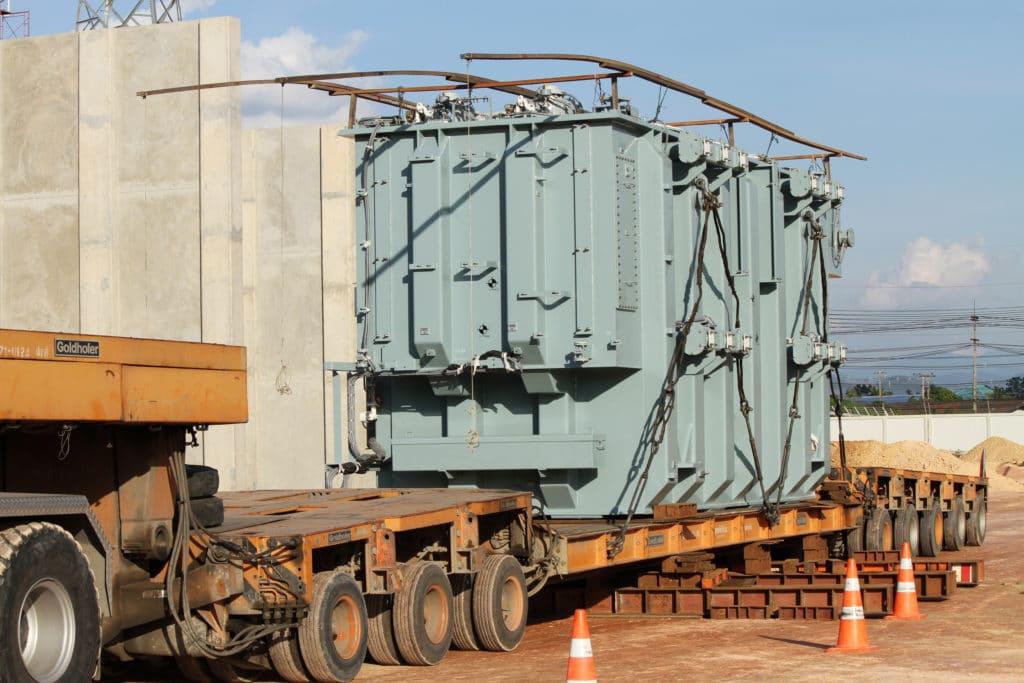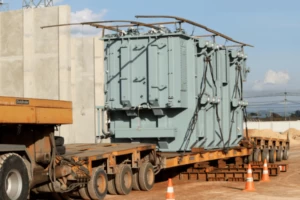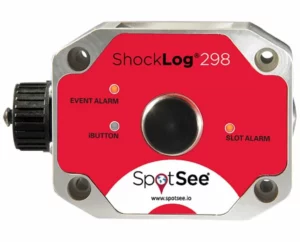
LATIN AMERICA TRANSFORMER MANUFACTURERS
Impact Monitors Limit Risks for Transformer Manufacturers  Moving a transformer from its manufacturing facility to its final destination usually takes 3 to 12 weeks, but transit times of 9 months aren’t unusual. As a transformer moves from trucks to rail cars, to ocean barges, and back, loaded and unloaded, positioned, and installed, it may experience multiple impacts. The longer a transformer is in transit, the greater its risk of damage. Manufacturers go to great lengths to prevent damage during handling, but accidents occasionally happen. When they do, it’s up to manufacturers to learn the extent of damage and to take the appropriate steps. To do this, they need to understand what happened. Record Impacts that Matter Impact monitors placed on a transformer during shipment provide an objective record of substantive impacts from the time it leaves the manufacturing facility to the time it is installed, sometimes half a world away. The impact threshold can be set to only record impacts that are severe enough to potentially damage critical components. Typically, that means longitudinal impacts of 3Gs or more, and both vertical and transverse impacts of 2Gs or more, but the available measurement range can be set with 2% accuracy between 1G and 200Gs. Damage caused by impacts such as these often isn’t visible and may not be evident until after the transformer is installed at its final destination. Damage is a result of low frequency (long duration) impacts. High frequency impacts, for example a metal chain used to secure the transformer may hit the metal transformer housing and ring. This impact would be high frequency (short duration) but would not be a damaging impact. To prevent false positives, the ShockLog 298 can be configured to ignore high frequencies. The ability to inspect transformers that may have been damaged during loading, unloading, and installation is a major benefit to manufacturers, but impact loggers have additional information that can streamline the insurance claims process. A time stamp and geographic coordinates, along with the direction, amplitude, and duration of impact, helps investigators determine exactly what happened – whether, for example, the transformer was dropped by a crane or impacted while on a rail car. Knowing the time and (optional) GPS coordinates can pin the incident to a location and sometimes even to specific personnel, so manufacturers can take steps (like retraining staff or rethinking procedures) to prevent such accidents in the future. Likewise, when transits are uneventful, monitors provide objective evidence that to supports claims of quality. Ease the Pain Points Transformers manufacturers face five common pain points:
Moving a transformer from its manufacturing facility to its final destination usually takes 3 to 12 weeks, but transit times of 9 months aren’t unusual. As a transformer moves from trucks to rail cars, to ocean barges, and back, loaded and unloaded, positioned, and installed, it may experience multiple impacts. The longer a transformer is in transit, the greater its risk of damage. Manufacturers go to great lengths to prevent damage during handling, but accidents occasionally happen. When they do, it’s up to manufacturers to learn the extent of damage and to take the appropriate steps. To do this, they need to understand what happened. Record Impacts that Matter Impact monitors placed on a transformer during shipment provide an objective record of substantive impacts from the time it leaves the manufacturing facility to the time it is installed, sometimes half a world away. The impact threshold can be set to only record impacts that are severe enough to potentially damage critical components. Typically, that means longitudinal impacts of 3Gs or more, and both vertical and transverse impacts of 2Gs or more, but the available measurement range can be set with 2% accuracy between 1G and 200Gs. Damage caused by impacts such as these often isn’t visible and may not be evident until after the transformer is installed at its final destination. Damage is a result of low frequency (long duration) impacts. High frequency impacts, for example a metal chain used to secure the transformer may hit the metal transformer housing and ring. This impact would be high frequency (short duration) but would not be a damaging impact. To prevent false positives, the ShockLog 298 can be configured to ignore high frequencies. The ability to inspect transformers that may have been damaged during loading, unloading, and installation is a major benefit to manufacturers, but impact loggers have additional information that can streamline the insurance claims process. A time stamp and geographic coordinates, along with the direction, amplitude, and duration of impact, helps investigators determine exactly what happened – whether, for example, the transformer was dropped by a crane or impacted while on a rail car. Knowing the time and (optional) GPS coordinates can pin the incident to a location and sometimes even to specific personnel, so manufacturers can take steps (like retraining staff or rethinking procedures) to prevent such accidents in the future. Likewise, when transits are uneventful, monitors provide objective evidence that to supports claims of quality. Ease the Pain Points Transformers manufacturers face five common pain points:
- Compliance
- Safety
- Product Education
- Calibration
- Reverse Logistics
Compliance Transformer customers often specify transport monitoring with a triaxial impact recorder and submission of a journey report. Non-compliance can result in contractual penalties. Manufacturers also must comply with industry standards and guidelines for transportation and installation, including IEEE C57.150-2012 (the IEEE Guide for the Transportation of Transformers and Reactors Rated 10 000 kVA or Higher) and IEEE C57.93-2007(the IEEE Guide for Installation and Maintenance of Liquid-Immersed Power Transformers). World-class transformer manufacturers like ABB, Siemens, GE, WEG, and Toshiba, also have strict internal quality assurance practices referencing IEEE standards. If a transformer malfunctions during startup and commissioning, impact recorders provide objective data showing how the transformer was handled. That information helps engineers find the root cause of the problem and potentially identify procedures to prevent similar incidents in the future. Safety The health and safety of the transformer depends on the safe and careful handling during transport, loading, and unloading. Sudden impacts can damage critical components in ways that aren’t visually evident, but impacts can’t be evaluated without an impact recorder. Because they record impacts above the thresholds set by the transformer manufacturer’s engineers, to know which transformers need time-consuming, potentially costly, diagnostics and tests, and which can be installed and commissioned. Therefore, they allocate time and resources where most needed. Product Education Impact recorders have a reputation as being difficult to use, but that really depends on the recorder. Transformers typically are received and installed onsite by field technicians and subcontractors who have no training for how to use the recorder and analyze its records. Other times, field technicians have a difficult time finding the right files or downloading and sending them to the manufacturer’s engineering team for evaluation. Then, the teams may be unsure how to analyze the field reports. For example, how do impact duration and amplitude affect the transformer? SpotSee’s automatically-generated reports remove the guess work. ShockLog 298 users can ask technicians on the receiving end to download the data and email them to the manufacturer, or project engineers can utilize the ShockLog 298 connected solutions – ShockLog Cellular or ShockLog Satellite, to report issues to them automatically. Calibration Transformer manufacturers need to renew their ShockLog calibration certificates every 12 months (or after damage) to guarantee the impact data is accurate and to comply with their own quality assurance systems. SpotSee has various calibration labs around the world, to make recalibration easier for Latin American customers. Reverse Logistics Once an impact monitor is shipped with a transformer, there’s no guarantee the device will be returned or, when it is returned, whether it will be in good condition. Small manufacturers report that 30% of their recorders are not returned. Larger manufacturers report losses of 75% of recorders. To counter this, some transformer manufacturers include the cost of the impact monitor in the cost of the transformer. The ShockLog 298 Advantage Unlike many impact monitors, SpotSee’s ShockLog 298 generates automatic, user-friendly, mission reports. Users can examine individual events, slots, and summaries to analyze specific impact events. Peak values of threshold-exceeding impacts are shown in an easy-to-read chart with the date, time, direction, amplitude, and duration of multiple impacts for the X, Y, and Z axes. This data, plus a detailed impact curve, removes the guesswork from analyses. ShockLog 298 records up to 870 events and 262,000-time slots to ensure that all threshold events are recorded, despite long mission times. And, with up to 18 months of battery life, there’s no need to recharge or replace batteries mid-transit. The ShockLog 298 is IP-67 rated. Which means it is dust tight and can withstand submersion in up to 1 meter of water for at least 30 minutes. It is designed for the harsh environments common to transformers.
Once an impact monitor is shipped with a transformer, there’s no guarantee the device will be returned or, when it is returned, whether it will be in good condition. Small manufacturers report that 30% of their recorders are not returned. Larger manufacturers report losses of 75% of recorders. To counter this, some transformer manufacturers include the cost of the impact monitor in the cost of the transformer. The ShockLog 298 Advantage Unlike many impact monitors, SpotSee’s ShockLog 298 generates automatic, user-friendly, mission reports. Users can examine individual events, slots, and summaries to analyze specific impact events. Peak values of threshold-exceeding impacts are shown in an easy-to-read chart with the date, time, direction, amplitude, and duration of multiple impacts for the X, Y, and Z axes. This data, plus a detailed impact curve, removes the guesswork from analyses. ShockLog 298 records up to 870 events and 262,000-time slots to ensure that all threshold events are recorded, despite long mission times. And, with up to 18 months of battery life, there’s no need to recharge or replace batteries mid-transit. The ShockLog 298 is IP-67 rated. Which means it is dust tight and can withstand submersion in up to 1 meter of water for at least 30 minutes. It is designed for the harsh environments common to transformers. How to Use the ShockLog 298 in 7 Easy Steps Using the ShockLog 298 is straightforward. Set it up. Put it on the transformer. Turn it on. Download the data. Analyze the results. Store the unit until it’s needed again. Depending on the size and weight of the transformer, some manufacturers install two recorders in different locations. Regardless whether one or two recorders are used, the process is the same:
How to Use the ShockLog 298 in 7 Easy Steps Using the ShockLog 298 is straightforward. Set it up. Put it on the transformer. Turn it on. Download the data. Analyze the results. Store the unit until it’s needed again. Depending on the size and weight of the transformer, some manufacturers install two recorders in different locations. Regardless whether one or two recorders are used, the process is the same:
- Configure the impact monitor: ShockLog 298’s software is intuitive, so a project engineer can easily set up the right configuration and either email it or put it on a USP stick for the logistic team.
- Put the monitor on the transformer: A logistics specialist usually puts the impact monitor into a steel box for protection and bolts it onto the transformer.
- Download the configuration and turn on the device. Press the iButton® on the face of the impact monitor to turn it on. Doing this before it’s moved enhances transparency and ensures that impacts are recorded throughout the entire mission.
- Stop recording once the transformer is in its final position. Press the iButton® to stop recording data.
- Download the data. A field or service engineer will download the mission data from the logger using a USB cable and ShockLog software. Email the files to the project engineer for analysis or, an iButton can gather the mission report.
- Analyze the reports. Using ShockLog software, the project engineer will analyze the impact reports to determine whether the transformer experienced any above threshold events and will submit a final report to the customer.
- Return the monitor or store it for future use. The customer returns the impact monitor to the transformer’s manufacturer or to the customer’s logistics site for reconfiguration and reuse. If more than 12 months pass between the start of each mission, return the monitor to SpotSee for recalibration.
Impact Monitoring Saves Money and Time Impact monitors save transformer manufacturers time and money by determining which transformers need potentially costly field diagnostics and testing and which don’t. If no unacceptable impact events were recorded, field engineers can proceed with installation or focus their attention on other transformers that may have experienced damage. With in-field service costing approximately US $150 per hour and often taking 48 hours to complete, impact monitoring can save significant monies. An impact monitor saves more than just testing time. The choice of INCOterms determines liability among the manufacturer, carrier, and customer. Therefore, the cost of diagnosing and repairing damage may not be the manufacturer’s responsibility. An impact monitor can prove where damage-causing impacts occurred. Likewise, the objective evidence provided by an impact monitor can be used in insurance claims to prove liability. If the transportation and final installation is included in the transformer manufacturer’s scope of work, and damage occurs, the presence of objective impact data may show the damage is not caused by the manufacturer’s inattention but by other factors and other parties. Finally, knowing that an impact event occurred before the transformer is installed – sometimes even in transit – allows the transformer to be examined and repaired before installation and commissioning. This can prevent a catastrophic failure that may cost millions of dollars, delay projects, and endanger human lives and the environment. ShockLog 298 is field-proven, and used by some of the world’s largest, most dependable transformer manufacturers, including ABB, GE, Hitachi, Siemens, Schneider, WEG, and Toshiba. To see how ShockLog 298 can protect your transformers during shipping, contact SpotSee. Learn more about SpotSee and ShockLog at srvcontrols.com/impact.

